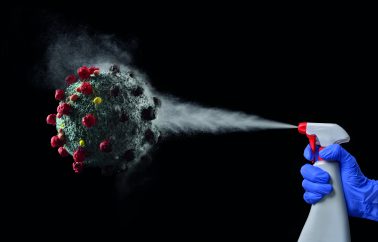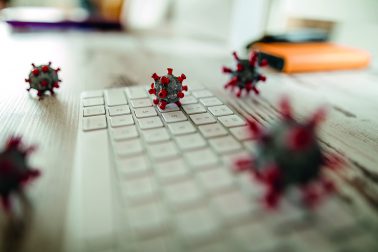Keeping it clean: how COVID-19 has changed the way we clean workplaces

The COVID-19 pandemic has changed the way that all businesses operate. For those companies that are taking steps to reopen, the requirement to limit viral transmission and clean the workplace regularly can seem overwhelming.
However, with diligent planning, fit-for-purpose products and practical staff training in place, businesses can kick-start their operations and implement effective cleaning processes without compromising workplace efficiency.
Making the workplace safe – what the law says
Health and safety legislation in the UK mandates that employers must provide a certain level of cleanliness in the workplace under the Workplace (Health, Safety and Welfare) Regulations 1992. Employers are obligated to provide workplaces with clean floors, stairs, premises, furniture and fittings, and to clean dirt, refuse and spills promptly.
Now, employers have additional obligations to provide a COVID-safe environment. The HSE has issued guidelines to help make workplaces COVID-secure during the pandemic, including how to clean workplace premises, bathrooms and vehicles, and how to train cleaning staff to handle the new challenges.
Cleaning and COSHH compliance
COSHH, or the Control of Substances Hazardous to Health Regulations 2002, requires employers to control the use of harmful substances. More frequent cleaning will increase the risks associated with COSHH, as employees will be handling hazardous substances to carry out more thorough and frequent cleaning activities.
To be COSHH compliant, employers must ensure that potentially dangerous substances or flammable liquids are stored in specialist bins or cabinets. Safety data sheets detailing hazard/health effect details alongside general handling precautions must be provided by the supplier to meet their legal responsibilities. These can be kept in COSHH ring binders or safety document holders, close to the hazardous materials. Chemical handling instructional guides are also available to ensure that employees are properly informed about how to protect themselves.

Cleaning and COVID-19
According to Public Health England, the risk of infection can depend on the type of surface that is contaminated, the amount of virus that an individual sheds, how much time the individual spent in an area, and how much time has passed since they left.
The main route of transmission for COVID-19 is from airborne droplets spread through coughing, talking or sneezing. These can be directly inhaled, or picked up from surfaces where the droplets may have landed. The length of time that the virus can survive on a surface will depend on factors such as:
- The type of surface, i.e. metal, plastic, cardboard, fabric, etc.
- Whether the surface is exposed to sunlight
- Temperature and humidity levels
- Exposure to cleaning products
Previous laboratory testing had confirmed that the virus can survive for up to six days on smooth surfaces such as plastic and stainless steel. However, new research published by Australian agency CSIRO has found that the COVID-19 virus can remain infectious on non-porous surfaces for up to 28 days in the right conditions.
Cleaning, disinfecting and sanitising
The terms ‘cleaning’, ‘disinfecting’ and ‘sanitising’ are often used interchangeably to describe the same processes. However, these processes are different and have varying levels of effectiveness.
- Cleaning refers to the physical process of removing germs, dirt, bacteria and viruses from a surface. Importantly, cleaning does not necessarily kill germs and bacteria, but it will move the germs off the surfaces and objects that people are more likely to come into contact with, such as countertops, handles – and even hands.
- Disinfecting typically involves the use of chemicals, or ’antimicrobials‘, to kill germs, pathogens and micro-organisms that cause disease. Unlike cleaning, disinfecting does not necessarily mean that dirt or grime is removed from a surface, but the germs that live on that surface will be killed. This limits the potential spread of infection from the germs.
- Sanitising eliminates almost all bacteria on a surface, which in turn decreases the risk of infection. However, even though sanitisers kill 99.999% of bacteria, the use of sanitisers alone cannot destroy all viruses.
Public Health England has a series of recommendations for cleaning and disinfection in the workplace, along with specifications about the kinds of disinfectants that should be used.
How to implement an effective cleaning regime during COVID-19
To develop a comprehensive cleaning plan for a workspace, it is important to start by carrying out a COVID-19 risk assessment to identify areas that are frequently touched and will therefore require regular cleaning.
Public Health England recommends that, where possible, clutter should be reduced and that, for general cleaning purposes, surfaces should be wiped down at least twice a day. One of these applications should be at the beginning or end of the working day. In ‘non-healthcare’ settings standard cleaning products, such as detergents and bleach, can be used as usual, and should be applied to all surfaces, but especially those that are touched frequently, such as door handles, light switches, work surfaces and taps.
‘High touch’ areas, such as bathrooms and communal kitchens, and workplaces that see a high level of traffic, such as stores, gyms or busy warehouses, may need to be sanitised more regularly to minimise transmission. Employers should stock up on the correct cleaning products and sanitisers to keep the workplace COVID-safe.
Employees should receive training in all aspects of the cleaning plan, including how to properly clean surfaces, how to use products in a way that is compliant with COSHH, and the correct wearing of PPE. They should also be trained to maintain good workplace organisation, using purpose designed solutions, such as cleaning stations and trolleys, for the safe storage of equipment and products. Information and instructional signage are also essential tools to notify staff or visitors that rigorous cleaning practices are in place and that the correct hygiene protocols should be observed.
Social distancing should form part of your risk assessment. Some of the measures you can put in place include using heavy-duty floor tape, paint or floor signs to demarcate work areas and installing social distancing and infection control signage to remind staff, customers and visitors to keep a 2m distance, practise good handwashing techniques, and to use hand sanitiser stations.
